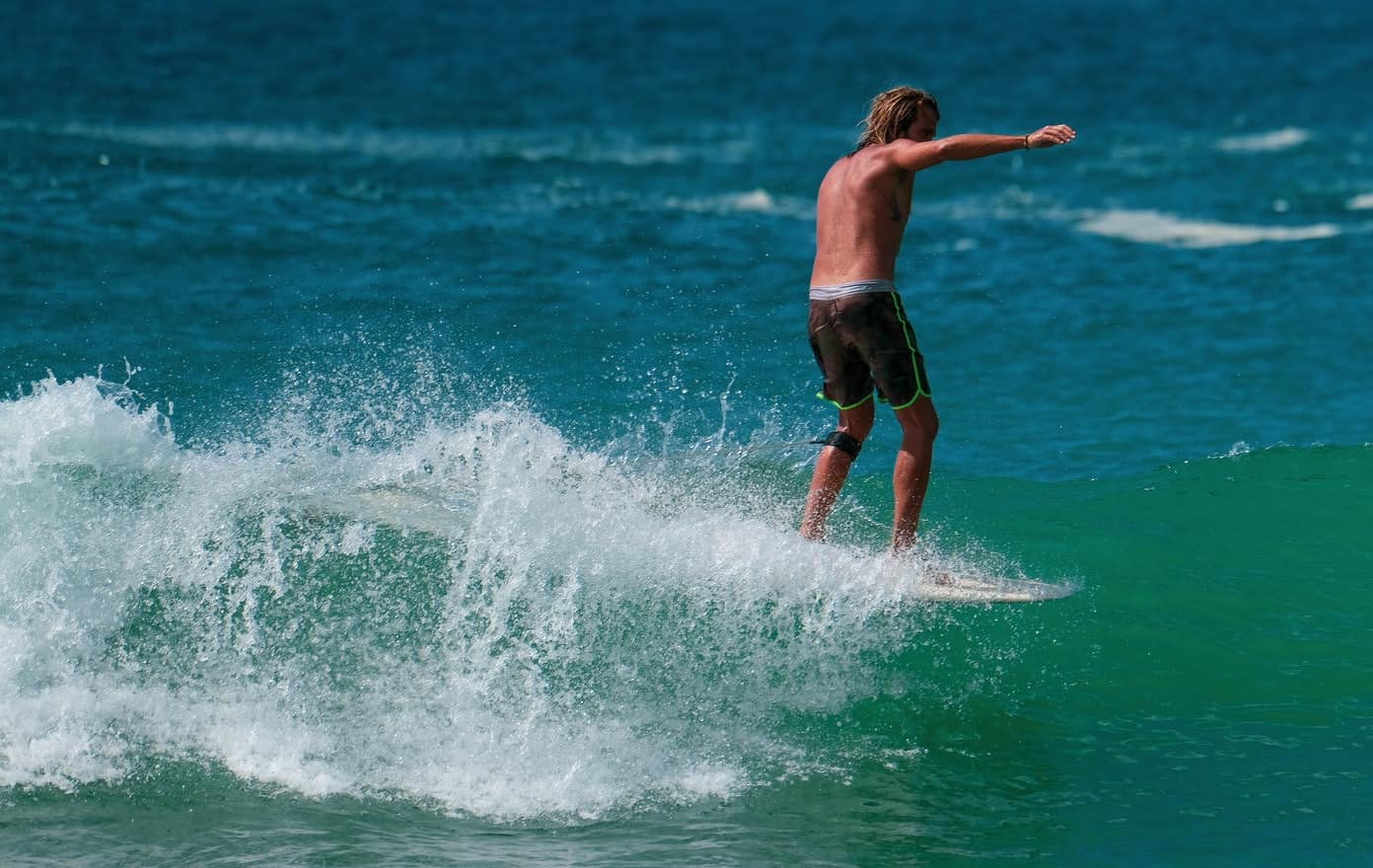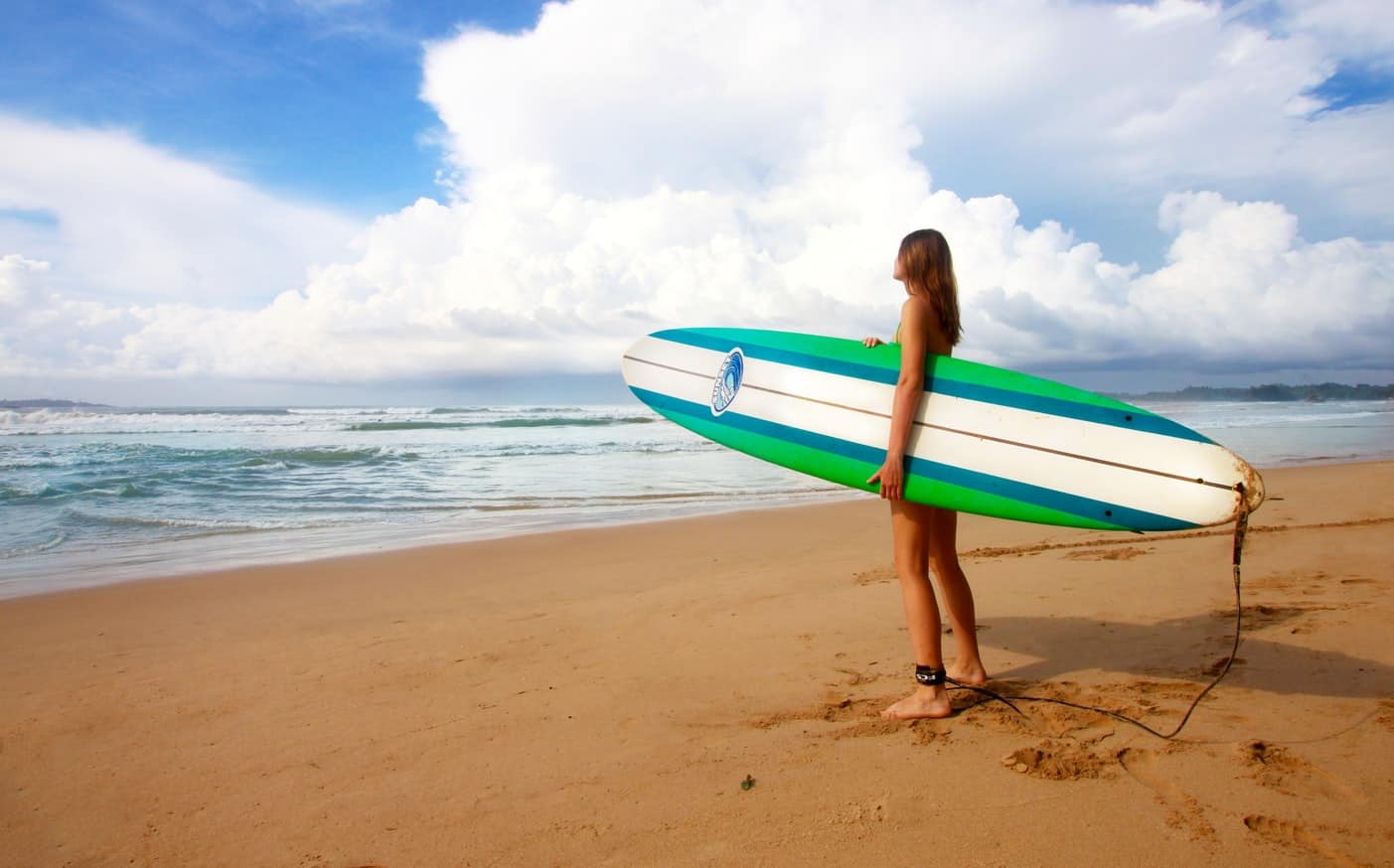There is a lot that goes into catching a wave. While it may seem simple when watching surfers from the shore, it actually requires serious skill and technique to land a wave.
You have to read the water to tell when a wave is coming, paddle into it and pop yourself up into standing and you have to do it all in the blink of an eye.
So what do you do when you feel like your pop up is lagging and causing you to miss out? How do you pop up faster?
In order to pop up faster while surfing, you need practice, form and strong muscles.
Popping up is when you move from the belly down, prone position of paddling, into the upright standing position of riding a wave.
Becoming better and faster at popping up is like any other skill. It takes time, patience and a lot of practice.
You should always start out on the ground to master the body positioning required to pop up properly. Have someone watch you, or video tape yourself to critique your form.
Do it slow at first until you’ve mastered the form, then practice it as fast as you can.
Popping up on the water is more challenging than on the sand. The movement of the water and yourself on the board requires a lot of balance and skill.
Don’t get discouraged if it takes awhile to perfect. Training and stretching the necessary muscles and joints outside of your sessions will also help to speed up your pop up.
How to Pop Up
The first way to speed up your pop up is to make sure you’re doing it right. Let’s break it down.
- Paddle out until you’ve caught the wave and you can feel it pushing you forward
- Place hands flat on the board under your chest, not on the rails as this will mess with your balance
- Lift into “upward facing dog” position. Lift chest and hips, arching lower back, toes flexed and bearing most of the weight
- Bring back foot into position, slightly behind you
- Bring front foot into position, underneath chest, staying low to maintain balance
- Let go of board, keeping squat position for balance, extend an arm in either direction for extra balance
Practice this in smaller whitewater waves. Make sure your feet stay in the center of the board (on the stringer), positioning yourself around the middle.
This will help you stay balanced.
Speaking of balance, keep the knees bent, avoid standing up tall on your board. Bent knees will provide better stability.
Once you have the motions down, these next steps will help you speed up the process.
Strength Training Exercises
Although the act of surfing and popping up themselves will help train and strengthen your muscles, it’s important to work on exercises out of the water to improve.
Training outside of surfing itself will help you build strength faster. In turn this will help you maintain proper position in your pop up and go through the motions much more quickly.
These exercises will help you hit the important muscle groups you need to pop up efficiently.
Focus on form over speed. While it may feel counterintuitive, slower, controlled movements will help you more in the long run than sloppy, quick movements.
The point is to strengthen the correct muscles. Poor form here will only contribute to poor form in your pop up.
Once you have these moves down, you will definitely build more speed.
Burpees
Burpees are a quintessential pop up exercise as it incorporates several components of the pop up. It’s also perfect for strengthening the chest, arms, core and legs in one exercise.
- Start in standing position, feet hip width apart, shoulders back, spine in straight line, eyes facing forward
- Jump down into plank position, toes pointed down, legs together, quads facing down, core tucked in and hips lifted to create straight spine, arms and hands directly underneath shoulder, eyes down and slightly forward, neck in neutral position
- Slowly do one pushup maintaining plank position
- Jump feet towards hands landing in squatting position, feet directly below knees
- Lift hands off the ground and vertical jump up from squatting position
- Return to start
- Do as quickly as you can maintain form for 10 reps
Switch Lunges
Switch lunges work the lower body as well as improving your balance. This move will help as you get used to quickly placing your feet and rising in your pop up
- Start in lunge position, right foot forward, knee slightly bent, foot directly below knee in straight line, left foot back and slightly bent, hips tucked and facing forward to create straight spine, abs in, shoulders back, eyes straight ahead
- Slowly lower down until front knee reaches 90 degrees
- Using the lower body’s force, quickly jump up and switch feet, landing in lunge position with left foot now forward
- Adjust stance to proper form and repeat
- Do as quickly as you can maintain proper form for 10 reps

Push Ups
Push ups are an obvious choice in building pop up strength. This will help you build the necessary strength to lift your body off your board quickly to move through your pop up.
- Start in plank position, spine in straight line, neck in neutral position with eyes down and slightly forward, arms and hands directly under shoulder, abs in, hips lifted in line with spine, legs together and pointed down
- Slowly lower your body as far as it can go while maintaining body positioning, if the hips start to dip you’ve gone too far
- Slowly raise back into starting position
- Repeat for 10 reps
In and Out Knees with Sliders
In and Out Knees is a great exercise to target the core while simultaneously working the upper body and quads.
This exercise goes a long way to help you quickly get your feet underneath you in your pop up.
You’ll need sliders for this exercise. You can buy some or simply use two tea cloths if you’re on hardwood floor, or two plastic tupperware tops if you’re on carpet
- Place sliders under feet
- Start in plank position, neck neutral, spine straight, abs tucked in, hips lifted in line with spine, legs together
- Arms can be straight, with hands planted directly below shoulders, or bent with forearms planted, elbows directly below shoulders
- With feet on sliders, slowly draw both feet up toward armpits making sure abs are pressed towards the back to prevent back injury
- Go as far as you can while maintaining proper form and slowly slide feet back to starting position
- Repeat for 10 reps
Mobility Training Exercises
Mobility or range of motion is the flip side to strength.
While it’s important to be strong enough to move through the pop up technique quickly, having good mobility and range of motion is also imperative.
These moves will help to improve your joint mobility in order to help you get better at your pop up technique.
Lunge and Twist
The twisting lunge is great for overall mobility. It will stretch out the chest, spine, hips and thighs for overall improvement to your range of motion.
- Start in lunge position, right foot forward, foot directly below knee at 90 degree angle, left foot back in line with left hip, hips tucked and facing forward, spine straight, shoulders back
- Place both hands flat to the ground on the inside of the right thigh
- Lift left hand up to the sky, creating straight line from shoulder to fingertip
- Keep planted arm strong, making sure to keep shoulder from collapsing
- For deeper stretch place extended arm behind back, turning shoulder and chest up toward sky
- Return hands to start
- Place right foot back to meet left in plank position
- Move left foot up into lunge
- Repeat move on left hand side
Reclined Pigeon Pose
Pigeon pose is essential to opening up the hips. As the hips are doing a lot of work moving through a pop up, it’s important to have them loose.
This variation of the traditional pigeon pose will open the hips while protecting the back
- Start lying down on your back, eyes up to the sky, low belly pulled in to create neutral spine, legs straight out, toes and quads pointed up
- Point left leg up towards the sky creating straight line from the hip joint
- Bend right leg at the knee
- Cross right foot over left leg, above the knee cap on the quad creating triangle shape
- Place hands behind left knee on either side of the leg
- Bend left leg and slowly draw towards the face, maintaining cross legged position
- You should feel the stretch in the right hip joint
- Slowly return to starting position and repeat on opposite leg
Up Dog to Down Dog
Upward facing dog helps with flexibility in the back as well as stretching out the core and the quads. It’s also similar to the position you take during your pop up.
Downward facing dog also helps with back flexibility as well as stretching out the hamstrings and the upper back.
Gliding between the two positions is a great way to improve your overall mobility.
- Start lying face down, belly to floor
- Place hands just underneath shoulders and lift body off the ground, arching the lower back
- Hands should be stabilized with weight in palms to prevent collapsing of shoulders
- Abs tucked in, hips and quads lifted off the floor to prevent pressure in low back
- Toes pointed
- Hold up dog stretch for 5-10 counts
- Slowly lift hips up towards the sky, shifting some weight back into the feet
- Move feet to hip width apart, toes pointed forward
- Hands slightly in front of shoulders, inside of the arms pointed forwards, weight in the fingertips not the wrist, elbows slightly bent
- Gently pedal out the feet to loosen the hamstrings
- Hold down dog for 5-10 counts
- Slowly lower back to original starting position and repeat
Tree Pose
Tree pose is multi-functional in that it works on balance, while stretching and opening up the inner thigh.
- Start in standing position, feet hip width apart, hips tucked, abs in, spine straight, shoulders rolled back, neck in line with spine, eyes forward, hands by side
- Slowly lift right leg to be level with the hips, knee bent
- Place hands together at chest or hold out to the sides for balance
- Place right foot on either left calf or inside of left thigh, staying away from the left knee itself
- Point right knee towards the right hand side of the room, you should feel the stretch through the inner thigh and groin of the right leg
- Hold for 5-10 counts
- Lower back to standing
- Repeat on opposite leg
Related Questions
How do you know when to pop up?
Knowing when the right time to pop up takes time and practice to perfect. Even people that have been surfing for years sometimes miss a wave or go for it too soon.
The right time to pop up is when you feel the wave “has you”. Meaning once the speed of your board matches the speed of the wave and is being carried. This is when you should pop up.
Is surfing difficult to learn?
Surfing is like any other skill, it takes time, patience and dedication. There is a lot to learn when it comes to surfing, from technical skill of catching the waves to reading them to tell when a wave is coming.
The difficulty of learning to surf depends on the individual, their current fitness level and interest in learning.

